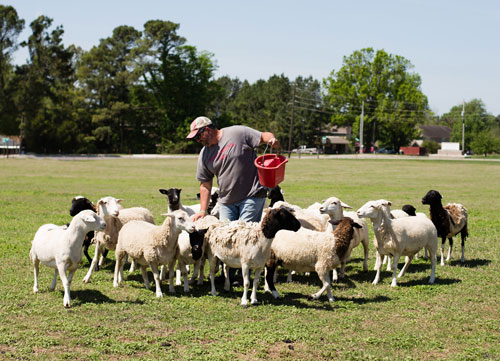Agriculture and Natural Resources Blog
Contact
Dr. Dan Quadros
Asst. Professor - Small Ruminants
Phone: 501-425-4657
Fax: 501-671-2185
Email: dquadros@uada.edu
University of Arkansas System
Division of Agriculture
Cooperative Extension Service
2301 S. University Ave.
Little Rock, AR 72204
Lower National Inventory Can Affect Sheep and Lamb Meat Supply and Demand Balance
By Dr. Dan Quadros - Small Ruminant Specialist
February 8, 2023
 The U.S. Department of Agriculture has just released the 2022 annual sheep inventory
report. According to the data, all sheep and lambs’ inventory was down 1%. Now, the
current inventory is approximately 5.02 million head. The breeding flock of ewes decreased
1.0%, reaching 2.87 million head.
The U.S. Department of Agriculture has just released the 2022 annual sheep inventory
report. According to the data, all sheep and lambs’ inventory was down 1%. Now, the
current inventory is approximately 5.02 million head. The breeding flock of ewes decreased
1.0%, reaching 2.87 million head.
Total market sheep and lambs was steady compared to 2021, with 1.36 million head. But there were considerable changes when we break it down into categories. The market lamb, which comprised 94% of the total market inventory, under 65 lb and 65-85 lb were down 2.9% and 2.1%, respectively. However, lambs weighing 85-105 lb and over 105 lb increased 4.9% and 0.9%, respectively, compared to the previous year.
How does lower sheep and lamb inventory affect the market?
The lower inventory will likely affect supply and demand balance. Additionally, inventory and prices may affect each other in a cause-effect relationship. After the lamb meat prices peaked in 2021/beginning of 2022, there was a considerable increment in feeding lambs for the traditional market. With high supply and a significant cut in restaurant services due to the pandemic, lamb prices went down dramatically after March 2022. Other factors, such as inflation, which limited consumer spending, and higher feed costs, also influenced the market. The nontraditional lamb meat market, which focuses on light carcasses, was less affected.
Lamb meat imports, which increased almost 60% in the last 10 years, tend to increase even more in 2023 with the reduction of national supply. In Australia, where most of the lamb meat is imported from, the flock grew 7.2% (5.2 million head) in 2022 compared to 2021 due to the favorable seasonal conditions, which supported higher lambing crop and larger breeding ewe flock.
The situation imposes more challenges on the American sheep industry, which is already struggling to keep a premium lamb meat supply or compete with Australia regarding the costs of regular sheep and lamb meat.
It is time to increase efficiency, for instance, by reducing feeding costs with pasture management and using alternative feeds, better health management, genetic improvement, and other techniques that can positively impact reproduction and lambing crop. Here at UADA, we are working with our Extension agents to educate producers on how to increase efficiency by applying the fundamentals of sheep production, helping them in these challenging times.
References:
Statista. U.S. Total Lamb and Mutton Imports and Exports from 2006 to 2034 (in million pounds)